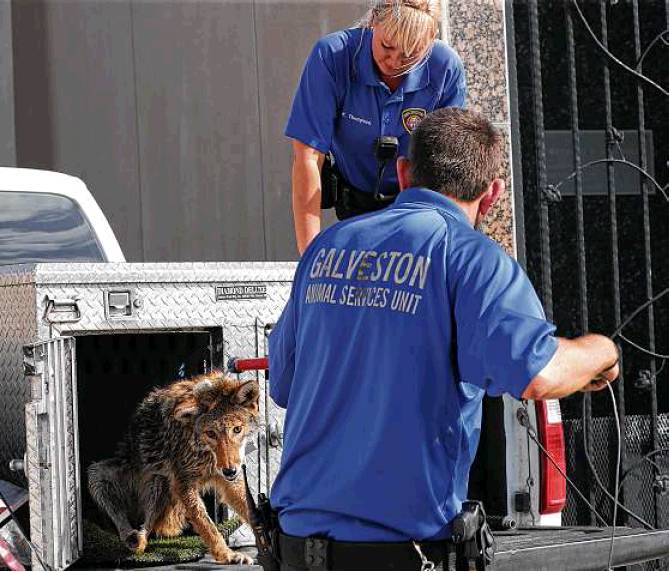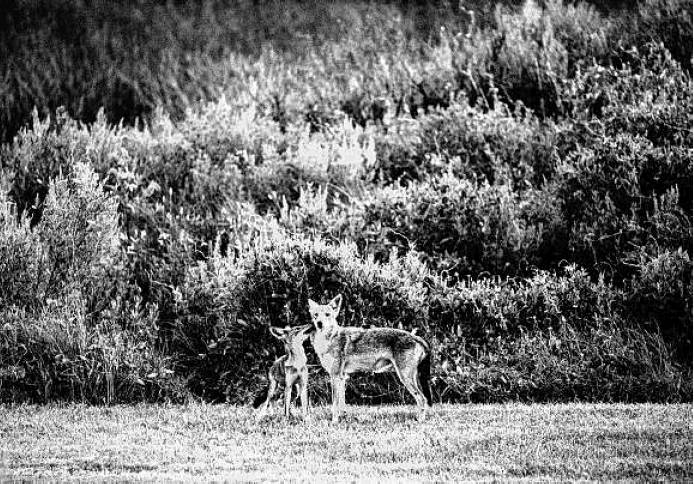Collaring the coyotes
Galveston hopes devices help animals, humans better coexist
By Keri Heath GALVESTON COUNTY DAILY NEWS
GALVESTON — Josh Henderson, animal services supervisor with the Police Department here, picked up the wet, 28-pound female coyote and carried her inside the Galveston Island Humane Society.
When he carried her out just a few minutes later, the coyote sported a new accessory — a GPS collar that will track the animal’s movements for 18 months.
The coyote was one of only two sporting the new collars in Galveston. But Henderson said he hopes to acquire enough devices to track at least one animal from every pack.
The collars are meant to provide information that could help coyotes and humans better coexist on the island, he said. But the data and tracking information gathered from the collars also are helping to inform a broader study about rare red wolf DNA found in Gulf Coast coyotes.
Henderson and animal services officer Kristen Thompson caught the coyote in a backyard after homeowners called animal control. The officers chased the coyote around the yard until it jumped into a swimming pool and they were able to capture it, Henderson said.
“What he’s getting right now is abducted by aliens,” Henderson said as he collected blood and hair samples from the captured female coyote. “It’s an intense form of hazing. When he’s done with his lovely little field trip, he is not going to want anything to do with the yard where he was abducted by aliens.”
Living with coyotes
The collars won’t impede the coyotes in any way, Henderson said.
What they do is ping a location every four hours, and that data will help Galvestonians better understand the resident coyote packs scattered across the island, Henderson said.
“It definitely will influence our coyote management plan as we go forward,” he said. “It’s like everything else — the more information you have, the better decisions you can make.”
Galveston’s coyotes have been a source of fascination and concern among residents for years. Although the animals have been known to attack cats or small dogs, coyotes mostly don’t bother humans, Henderson said.
Occasionally, social media posts and community chatter about coyote sightings spike up, sometimes with claims populations are growing. Henderson, however, maintains the island coyote population is pretty stable.
Coyotes change territories as humans change the environment, Thompson said.
As code enforcement tackles properties with high grass, coyotes move from the freshly mowed areas where they no longer can hide, she said.
“More construction is going on,” Thompson said. “That’s taking out their habitat, as well. People think they’re moving into the city, but we’re moving into their territory.”
Vegetation also can influence where coyotes roam, Henderson said.
“All that landscaping provides fantastic places to hide,” he said. “Some of it is rodent rich. Pampas grass, banana trees are notorious for things like rats.”
Coyote run
The collar on the coyote that jumped in the swimming pool is the second of two Galveston acquired through grant funding. The collars usually run about $1,800 and gather data for 18 months, Henderson said.
The first collar is around the neck of a male coyote that roams around Jamaica Beach. Henderson captured and collared him in September after residents called about the coyote hiding under a car.
The data shows the coyote spends very little time in the Jamaica Beach subdivision and travels from 13 Mile Road to Indian Beach, a range of about 4 miles.
“If you take a 4-mile stretch from Colony Park, where does Colony Park sit in that territory?” Henderson said. “I’ll be able to answer that soon. Hopefully, as we move down the island, I’ll be able to connect those dots. We’ll actually be able to know where they’re all running.”
Red wolf data
The data also is part of a study partnership with programs at Princeton University and Michigan Technological University. The collars are funded through grants from the universities and other conservation groups as part of research into endangered red wolves.
In 2018, researchers discovered red wolf genes in Galveston coyotes, said Bridgette vonHoldt, associate professor at Princeton and co-director of the Gulf Coast Canine Project.
“With the coyotes we trap and collar, our goal is to first quantify how much red wolf ancestry we find in each animal and also simultaneously collect movement and diet data,” vonHoldt said. “Then we can analyze to ask questions if individual differences in movement or diet can be associated with red wolf ancestry levels.”
The ultimate goal is to find out whether the Galveston coyotes could help red wolves survive as a species, she said.
“We are thinking about ways in which the captive breeding program could leverage the red wolf genetics,” vonHoldt said.
Henderson ultimately wants a collar on a coyote in every pack in Galveston. He has submitted a $15,000 grant application, which would mean 10 more collars for Galveston.
That might be enough to cover the island’s many packs, Henderson said. He won’t know until he collects more data, though.
The collared coyote was released into a field about half a mile from where she was captured. After some encouragement, she sprinted off into the brush.


